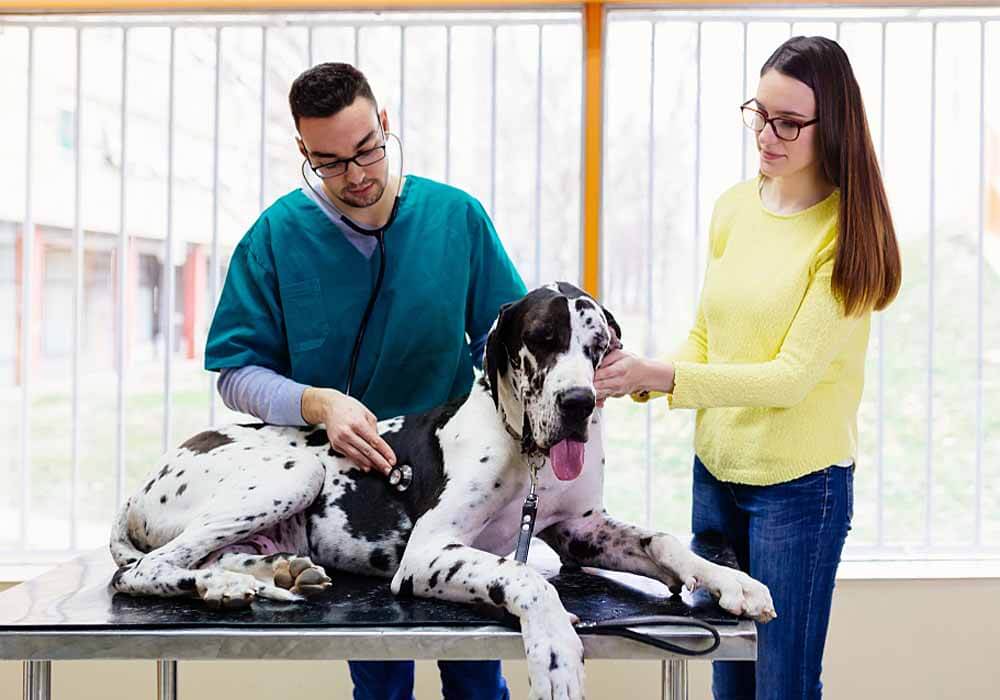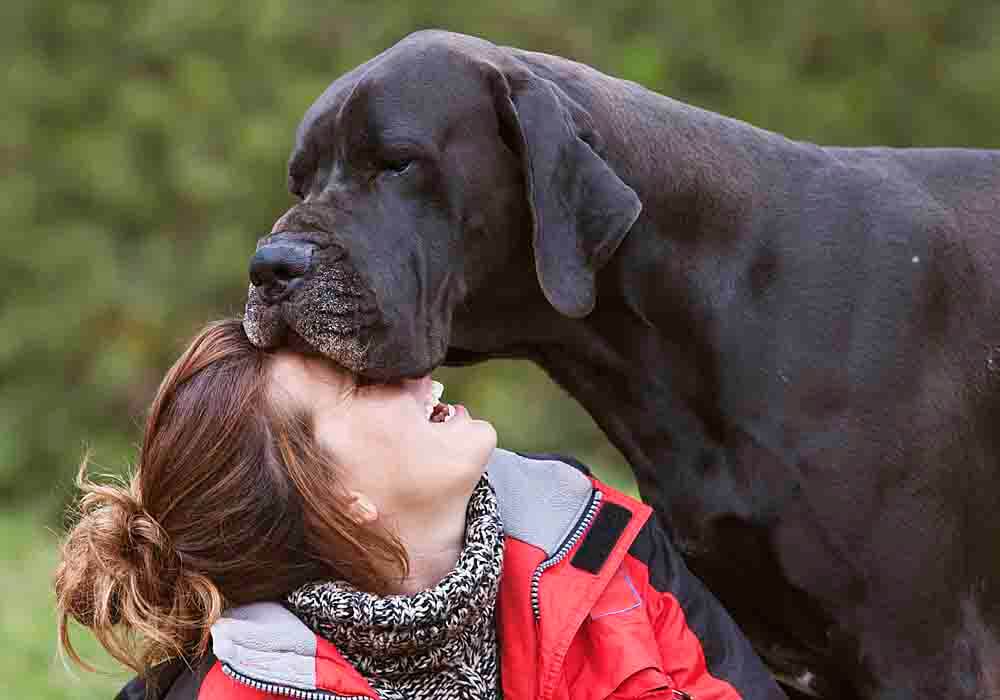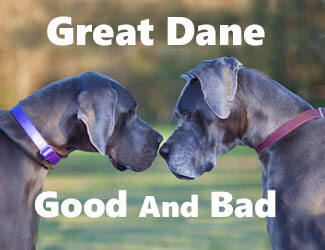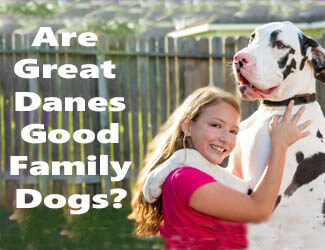Great Dane Health Concerns
26 Common Health Questions Answered
by Ken Alden
Great Danes are big beautiful dogs, but they can also run up some enormous veterinary bills. They have shorter expected life spans than most other dogs and can inherit several dangerous medical conditions. If you’re thinking about getting a Great Dane or currently own one, you need to know more about their health concerns.
Great Dane Health Concerns...What Are They?
Great Danes can be subject to serious medical conditions like bloat and hip dysplasia. They’re also prone to cherry eye and ectropion, which can be critical enough to need surgery or risk losing their vision. But when their nutritional and physical needs are met, they can live a long and happy life.
A Great Dane's potential health issues can be as intimidating as their size. But once you know what to look for, you’ll be in a better place to help your big friend. Read on to find answers to 26 common questions about
Disclaimer: The writers of this page are not veterinarians. The information we provide should not be a substitute for veterinary medical advice. Pet owners should always consult with their vet if they have any pet-related questions or concerns.
Pro-tip: Ever try lifting a Great Dane? Their weight can hurt not only your back but their joints when they hop down from cars, sofas or even your bed. To protect your back and theirs check out the best Mastiff ramps on Amazon.com now.

Why Do Great Danes Have Heart Problems?
Great Danes are prone to heart problems, such as dilated cardiomyopathy (DCM), which is a progressive disease. The cause is still unknown, though some say it may be hereditary.
The Great Dane's heart muscle grows thinner and their heart increasingly enlarged. As their heart rhythms become increasingly irregular, fluid build-up leads to swelling, malaise, breathing difficulties, and ultimately heart failure.
As your Great Dane gets older, your veterinarian may recommend annual cardio testing and EKGs to ensure their heart function remains healthy. DCM symptoms can be alleviated, and its progression slowed with medicine and dietary changes.
Why Do Great Danes Sleep So Much?
Great Danes sleep so much because they were bred for lower energy levels. Their ancestors were close protection dogs, who lived in noble houses and protected the family. But as they were originally used for hunting boars, they were overly active dogs and would tear up the manor furniture and carpets.
Now, Great Danes spend between 12 and 14 hours sleeping every day. And as they grow older, they start napping between their naps.
Why Does My Great Dane Keep Vomiting?
Your Great Dane may keep vomiting due to an intestinal blockage. Sometimes, dogs vomit because they ate something that they shouldn’t have. But if your Great Dane throws up multiple times for more than a day or two, you should contact your veterinarian immediately.
Pro-tip: Great Dane anxiety, aggression, destructive chewing, jumping up, fearfulness, and other behaviors can be controlled with the right training program.
Here’s a great course that
addresses these issues along with many other dog training basics: Check it out now!
Why Is My Great Dane Not Gaining Weight?
Your Great Dane puppy or rescue isn’t gaining weight because they may need deworming. Dogs can be subject to many parasite infections that will cause them to lose weight and ultimately lead to secondary infections.
You may fret that your Great Dane seems skinny, but they’re naturally lean-bodied. So long as your young pup isn’t emaciated or malnourished, they should be a bit underweight rather than overweight. And if your Great Dane isn’t as large as their littermates, remember that giants come in different sizes too.
Ask your veterinarian if you have any questions or concerns about your dog’s failure to gain weight.
Why Is My Great Dane Not Eating?
Your Great Dane may not be eating due to several reasons:
- Dental problems put dogs off their feed: It's hard to enjoy food when you have a toothache, and Great Danes can be sensitive to cavities and gum disease.
- They don't like low-quality food: Lower-quality dog food contains fillers that may upset your Dane's tummy and make them gassy. (Trust me, neither of you want this!)
- Stress can make dogs temporarily lose their appetite: If your Great Dane feels anxious about a big change, they might not eat as much, or at all, for a day or two.
Provide lots of love and reassurance to your fasting Great Dane and keep an eye on their behavior. Temporary loss of appetite could be due to a passing issue, or it could be a sign of something more serious.
Why Do Great Danes Get Bloat?
Great Danes get bloat because they swallow more air when they eat due to their loose jowly muzzle skin. If their stomach swells with too much air and food, it can twist so that the openings on both sides become tightly closed.
As trapped food ferments, the Great Dane's stomach fills with gas and blows up like a balloon. Pressure builds on the spleen and other internal organs. Tissues die as the swelling stomach cuts off circulation.
If left untreated, bloat is fatal. Even with surgical intervention and treatment, many Great Danes won’t survive an episode. An estimated 42.4% of all Great Danes experience bloat at some point in their lives.
To help prevent bloat in your Great Dane, consider a pre-emptive gastropexy. You should also feed your Great Dane smaller meals 2 or 3 times daily and avoid exercising your Dane for an hour after eating. Great Dane health concerns
Learn More Here: This article of ours discusses Mastiff Bloat in even greater detail.
Why Do Great Danes Get Cancer?
Great Danes are predisposed to some cancers, especially as they grow older.
Osteosarcoma in Great Danes
Osteosarcoma is a bone cancer that afflicts older Great Danes and other large and giant breeds. If you notice your middle-aged or senior Dane limping, call your vet immediately! The sooner a cancerous bone tumor is removed, the better your dog's prognosis. great dane health concerns
Lymphoma in Great Danes
Great Danes are more prone to canine lymphoma than any other breed. Treating your Great Dane's lymphoma will require a costly commitment for the rest of your dog's life. But success rates are excellent. Annual or bi-annual blood tests will help you nip lymphoma in the bud.
Hemangiosarcoma in Great Danes
Senior Great Danes can be prone to hemangiosarcomas. These bleeding tumors most commonly start in the spleen and often remain hidden until they burst and cause internal hemorrhaging. Annual blood tests and ultrasounds can catch hemangiosarcoma early.
Pro-tip: Great Dane's (and their owners) love dog crates…and for good reasons. Crates keep dogs from mischief while you're away, are perfect for house training, for traveling by car, and provide the dog a place to de-stress. Check out the best Mastiff crates on Amazon.com now.
Why Do Great Danes Fart So Much?
Great Danes fart so much because of several reasons:
- The bigger the dog, the bigger the fart. Great Danes can release a huge supply of toxic fumes. A chihuahua toot might never rise above your ankles. When a Great Dane lets one rip in the basement, you smell it in the attic.
- Drooling Great Danes swallow more air when eating -- and what goes in must come out. Other slobbery breeds like Saint Bernards, Mastiffs, Boxers, and English Bulldogs are also notorious canine cheese cutters.
- Table scraps may give Great Danes gas and other gastric disorders. High-quality food like Holistic Select Adult Dry Dog Food will keep your Great Dane's butt blasts to a minimum.
Now you know why Great Danes have a notorious and well-earned reputation as giant gasbags who are always stinking up the place.
Why Do Great Danes Get Diarrhea?
Great Danes get diarrhea because they have sensitive stomachs. Stress caused by separation anxiety can give them diarrhea and lead to in-house accidents. Worry caused by remodeling may even give your gentle giant a gargantuan case of the runs. Additionally, they can respond poorly to people's food.
So while it can be hard to resist those soulful eyes, high-fat table scraps can leave your Great Dane with loose stools. And while they may look intimidating, Great Danes are sensitive dogs. great dane health concerns
Why Do Great Danes Get Ear Infections?
Great Danes with uncropped floppy ears can be prone to ear infections. Floppy ears trap moisture in the ear canal, allowing for bacteria to grow. On the other hand, those with cropped ears are less likely to get ear infections. However, many people today consider ear-cropping cruel.
Though it can limit infections, ear cropping actually started when Great Danes were used for boar hunting. Their naturally floppy ears frequently sustained horrible wounds from boar tusks and teeth, so boar hunters began cropping the puppies' ears.
If you see your Great Dane scratching at their ears or notice a discharge coming from their ears, see a veterinarian immediately. Ear infections are as painful for dogs as for people. Weekly ear cleanings with a recommended ear cleaning solution can help you avoid ear problems or catch them early when they occur.
Why Do Great Danes Get Hiccups?
Great Danes get hiccups when their diaphragm goes into a spasm. Puppies are particularly prone to hiccuping. Between 2 to 6 months, a Great Dane puppy doubles their height and quadruples their weight; their body sometimes has trouble keeping up, including the vagal nerve controlling the diaphragm.
Most Great Dane puppies will grow out of hiccuping when they’re a year old, but some Great Danes will remain hiccup-prone their entire lives.
Why Do Great Danes Poop So Much?
Great Dane poop so much because they’re large dogs that can eat a lot. Though they don't eat as much as you might expect, these pony-sized pooches still can put away a couple of pounds (1 kg) of dog food in a day. And what goes in must come out. Great Danes are big dogs who leave large stools behind.
If you’re a Great Dane owner, please bring plastic bags with you and make sure your Great Dane's poop winds up in a garbage can. Leaving dog poop behind is not only rude, but it's also unhealthy and, in many jurisdictions, illegal.
Why Do Great Danes Shake Their Heads?
Great Danes may shake their heads because of ear pain. Head shaking is one of the primary signs of an ear infection, especially if your Great Dane is also pawing and scratching at his ear. If you see your dog head-shaking, check their ears for signs of ear mites, discharge, or inflammation.
Great Danes can also develop seizure disorders, especially as they get older. If your pup is showing seizures, a veterinarian can determine what’s wrong and, in most cases, provide medication. great dane health concernsGreat Dane health concerns
Why Do Great Danes Throw Up?
Great Danes throw up because they have sensitive stomachs, and they may eat their food too fast. Feeding your Great Dane small portions 2 or 3 times a day and softening their food may help them keep down their meals.
If your Great Dane is acting lethargic after vomiting or vomits more than once, give your veterinarian a call. Like people, dogs occasionally vomit over minor stomach upsets. But repeated vomiting, bloody vomiting, or lethargy could suggest more serious issues.
Why Do My Great Danes Chatter Their Teeth?
Your Great Danes may chatter their teeth when they’re excited or nervous. Their feelings are as big as their bodies, and they get the shivers when they’re emotionally overwhelmed. It may also be because they can’t handle the cold well, as they have very short coats and low body fat.
If you see your Great Dane shivering in winter, bring them indoors and look into a suitably sized winter coat. Chattering can also indicate oral pain or seizures. If your Great Dane's teeth are constantly chattering, consult your veterinarian.
Why Does My Great Dane Have Bad Gas?
Your Great Dane may have bad gas because you’re feeding them the wrong type of dog food. Soy and corn fillers do to your dog what a steady diet of bean burritos would do to you. If you want to keep your Great Dane’s gas to a minimum, feed them a higher-quality dog food.
Why Does My Great Dane Have Diarrhea?
Your Great Dane may have diarrhea because of a change in their diet. You may buy the same dog food you’ve been feeding your dog for years. But unbeknownst to you, the manufacturer made changes to the formula.
Loose stools may ensue until your dog's system gets used to the new changes -- or until you find a fresh dog food that suits your titan's tummy.
Why Do Great Danes Need Gastropexy?
Great Danes need gastropexy because they’re particularly sensitive to bloat, which is a serious and often fatal condition that results when a dog's stomach gets twisted inside their body. To prevent it, many vets will perform gastropexy at the same time they spay and neuter.
During a gastropexy, the veterinarian sutures the Great Dane's stomach to the right body wall. This ensures against the twisting that causes bloat.
If done early as a pre-emptive measure, gastropexy is a simple procedure. If performed during the surgical intervention for an active case of bloat, gastropexy can become more complicated and require lengthy hospital stays.
Why Do Great Danes Get Cherry Eye?
Great Danes are more prone to cherry eye because of their droopy skin and faces.
They have a third eyelid which provides their eye with extra protection. Beneath that third eyelid is the nictitans gland, which produces around 40% of a dog's lubricating tears. Normally, the nictitans gland hides comfortably under the eyelid, but sometimes, it slips out and becomes visible as a reddish swollen "cherry eye."
Cherry eye is so common that many owners don’t recognize it as a problem. Often a simple treatment with warm compresses will ease the swelling, but a persistent case of cherry eye will require a vet visit. If left untreated, it can be painful and may lead to vision loss.
Why Do Great Danes' Eyes Droop?
Great Danes’ eyes droop because they’re prone to ectropion (droopy lower eyelids), which is a common hereditary condition among dogs with loose, lax skin, just like St. Bernards, Bloodhounds, and other big saggy dogs. However, it can also occur in cases of corneal injury, eye infection, or inflammation.
In ectropion, the eyelid droops outward, which isn’t good but better than entropion, where the eyelashes and lower lid turn inward. If left untreated, entropion can lead to corneal damage, eye inflammation, or even blindness.
Although droopy eyes are common in Great Danes, should you notice recurring eye infections or discomfort, you may need to give your dog eye drops or consider surgical intervention. great dane health concerns
Why Do Great Danes Drink So Much Water?
Every day a Great Dane should drink at least 1 ounce (30ml) of water per pound (0.45kg) weight, and they'll happily drink that much and more. But generally, the amount of water a Great Dane drinks will vary each day and depend on the situation.
Great Danes drink so much water typically when it's so hot, and they're losing a lot of moisture panting to keep cool. Keep them out of the heat and in your air-conditioned home, and they'll drink and drool less. But excessive thirst over an extended period can also be a sign of diabetes, kidney problems, liver failure or other conditions.
If your Great Dane is drinking heavily and also seems ill or uncomfortable, consult your veterinarian.
Why Do Great Danes Drool So Much?
Great Danes drool so much because of their distinctive droopy jowls, which are a unique part of the breed’s charmingly goofy look. Those droopy jowls aren’t very good for holding saliva in their mouth. And so your drooling Dane sometimes leaves spit puddles on floors and furniture.
You can't stop your Great Dane from drooling, but you can arrange your home to keep the worst of their saliva floods in easy-to-clean areas.
Your Great Dane will slobber most after drinking, eating, or exercise, so keep towels nearby and move your feeding and water area away from your sofa and antique rug.
If your Dane is drooling and showing signs of discomfort, check for oral infections. And because drool is also a cooling mechanism, you should take your Great Dane indoors if they’re drooling too much outside, as they’re sensitive to overheating.
Why Do Great Danes Eat Grass?
Why Great Danes eat grass isn’t scientifically known. However, one of the possible and most common reasons is to relieve an upset stomach. They may also find the added fiber from grass helps them with bowel movements. Or maybe they just like the taste of grass. great dane health concerns
While grass isn’t harmful to dogs, lawns frequently get sprayed with toxic herbicides and pesticides, and eating grass can transmit intestinal parasites like hookworms and roundworms. If you see your Great Dane eating grass, offer them a treat and distract them by walking in another direction.
Why Do Great Danes Eat Rocks?
Great Danes eat rocks when they’re anxious, frustrated, or bored. When Great Dane puppies are teething, they’ll chew, bite, and swallow rocks to relieve their gum pain. Curious puppies will also get bored with their old chew toys and gnaw on a stone that smells of another animal.
Two commands which can save your Great Dane's life are "drop it" and "leave it." Teach them to drop rocks, or anything else they shouldn't be chewing, on command. Also, teach them to back away from the item they drop. These commands will help ensure against costly vet bills to remove swallowed objects.
Why Does My Great Dane Whine All The Time?
Great Danes can be very vocal dogs. While they usually reserve their deep warning bark for serious occasions, they’ll often whine to show their discontent. But while a 140-pound (65kg) behemoth whimpering like a scared Yorkie is amusing, a big dog whimpering through the night is no fun for anybody.
Your Great Dane may whine all the time because of pain, anxiety, boredom, or unhappiness. If you figure out what’s causing the stress, you can often fix the problem. Great Danes are also prone to worry, but these big babies respond very well to reassurance and positive reinforcement. great dane health concerns
Why Are Great Danes Eyes Red?
Great Danes' eyes are red because of ectropion, which causes the Danes’ lower eyelids to droop and expose the red mucous membrane below the eyeball. Those who own droopy-eyed Danes need to keep an eye on their dog's eyes. Danes can be prone to several eye diseases that can cause pain, infection, or even blindness.
According to the AKC Breed Standard, droopy red eyes (haws) are a serious flaw. While they won’t disqualify a Great Dane from a show immediately, judges will dock many points for red eyes and disqualify for entropion, cherry eye, or other serious eye issues.
Great Dane Health Concerns...Final Thoughts
Great Danes are a big responsibility, and looking out for their many potential health issues can be stressful. But many live long, happy, and loving lives once you make allowances for their conditions. Now you know more about things that might get you and your Dane going to the vet -- and knowing is half the battle!
Return to the top of this Great Dane Health Concerns page

About the Author...
Ken Alden, a dedicated Mastiff owner for over eight years, is acclaimed for his expertise in care, grooming, and training. Read more About Me and my dog Shadow.
- Mastiff Guide Home ›
- Great Danes Dog Info ›
- Great Dane Health Concerns





